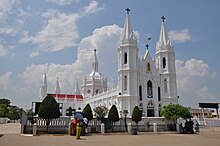Basilica of Our Lady of Good Health
The devotion has existed since the mid-sixteenth century, it is attributed to three separate events which occurred at the site: The apparition of the Madonna and Child to a slumbering shepherd boy, the miraculous healing of a handicapped buttermilk vendor and the rescue of Portuguese sailors from a deadly sea storm.
Initially, a modest chapel was built by the Portuguese from Goa and Bombay, soon after they washed ashore safely in spite of a severe tempest.
Pope John XXIII raised the Marian shrine to the status of a minor basilica via the pontifical decree Salutem Supplicibus Dilargiens, signed & notarised on 3 November 1962.
The third noteworthy incident is the reported miraculous rescue of the Portuguese in Goa and Bombay-Bassein, who were sailing away from a deadly monsoon surge and tempest, in the Bay of Bengal in the late 17th century.
A small shrine was built near the site where the boy encountered the woman, a location that came to be called Maatha Kulam, which means "Mother's well" in Tamil language.
After he drank it, the woman told the boy to visit a gentleman in the next town and ask him to build a chapel in her honour at that location.
A small thatched chapel was built shortly thereafter in honour of "Our Lady of Good Health" or Aarokia Maatha in Tamil.
[2] The third notable incident occurred when a Portuguese ship sailing from Macao to Ceylon (Sri Lanka) was caught in extreme weather in the Bay of Bengal.
This especially includes use of Kotimaram or Dwajasthamba, which has been described as an extended influence of Hinduism on Catholicism, thus making the basilica a meeting point of two of the major religions of the world.
[11][12] Due to the number of pilgrim visits during festival season, the Indian Railways introduced special train services to the town of Velankanni.
[3] The list of parish priests (mainly Portuguese) from 1771 until now is as follows:[15] The basilica is a recurring setting in the Tamil film Annai Velankanni (1971).




